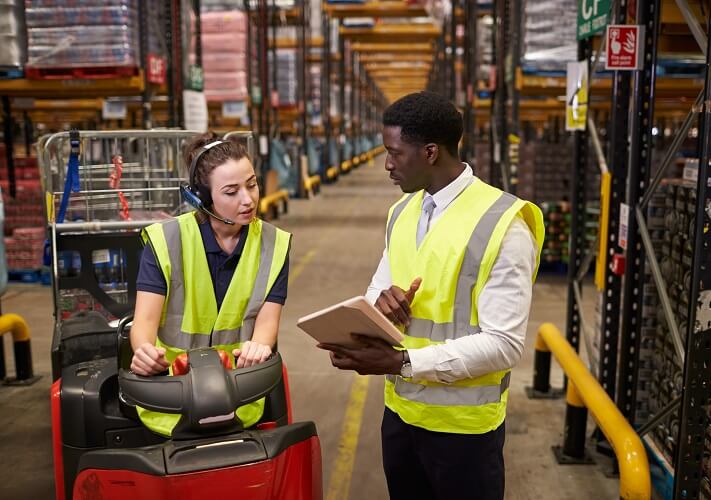How COVID-19 Impacted the Global Supply Chain
Throughout 2020 and part of 2021, countries worldwide took stringent measures to curb the spread of COVID-19 by ceasing commercial activities and implementing travel bans, shutdowns and work-from-home regulations.
As society rapidly reopens, businesses are recovering, and both manufacturer and consumer demands are rising sharply. Yet, multiple lockdowns — coupled with varying reopening approaches between regions — have restricted the transportation of finished goods and raw materials. Many global supply chain organizations have struggled in their efforts to reach full capacity, and some business leaders are questioning the viability of their reopening strategies. They learned from COVID-19 that many procurement and manufacturing processes lacked the fault tolerance needed to withstand a global disruption event. They have also taken this opportunity to uncover inefficiencies and unsustainable business practices.
Going forward, business leaders are looking for innovative ways to strengthen their global supply chain strategies so they can better withstand potential disruptions in the future. In their efforts to reach full capacity, many manufacturing leaders are seeking the right balance that meets immediate customer demands while also building sustainability and fault tolerance into their procurement and distribution processes.
Fault Tolerance Starts With Sustainability
As business leaders evaluate post-pandemic challenges and make changes to operations, many are also using the shift as an opportunity to reduce the amount of waste produced by their business practices. A strategy of sustainability requires deliberate steps to offset carbon footprint, such as minimizing packaging, combining shipments and improving routing efficiency. Many manufacturers are also considering how they can reduce the carbon footprint of their sourcing, redesign products for a longer lifespan and implement repair services, e-cycling and reclamation to further improve their sustainability initiatives and take advantage of the circular economy.
Achieving ecologically sound business practices can provide many advantages beyond those enjoyed by the surrounding ecosystems. Original equipment manufacturers (OEMs) that successfully implement sustainability practices can reduce packaging, handling and shipping costs; take advantage of tax breaks; and become qualified for government funding. Practicing sustainability also builds stronger public relations, which helps increase brand awareness and trust. With a focus on responsible and sustainable practices, business leaders can develop a platform for innovation, better growth opportunities and improved relations with partners and customers alike. These advantages can lead to additional strategic alliances and partnerships that form a foundation for fault-tolerant business practices.
Developing a Lasting Fault-Tolerant Supply Chain Strategy
The global shutdowns forced by COVID-19 brought stark awareness to the lack of fault tolerance and agility in existing supply chain strategies. The industry has historically prioritized cost-effectiveness by depending on single manufacturers, distributors or resellers for parts and raw goods. However, when those individual suppliers were forced to shut down, they became single points of failure for the businesses that struggled to keep their own operations running.
Throughout the pandemic, many industries also experienced widespread shortages in raw materials, which impacted operations from the OEM to the retailer. Additionally, consumer priorities shifted significantly, resulting in demands for goods that did not exist in the quantities required. These changes represented lucrative opportunities for the suppliers who could pivot their business practices to meet those needs, but unfortunately, many businesses lacked the necessary fault tolerance and agility, and their inherent strategic vulnerabilities led to the temporary or permanent closure of many operations.
As industries move toward full capacity, supply chain leaders have gained a newfound understanding of the essential need for supplier redundancy. Sourcing is a moving target based on a variety of controllable and uncontrollable factors. A diversified sourcing strategy, aided by advanced technology such as AI modeling, can improve the efficiency and effectiveness of the supply chain from end to end. However, reaching this goal requires rethinking procurement and business relationship strategies. Effective, fault-tolerant global supply chain strategies are built on a combination of three things:
- Nearshoring: Procurement from local sources made a significant resurgence as a fault-tolerant supply alternative, first due to shutdowns in the Asia-Pacific region, and then because of the increase in manufacturing costs in certain Asia-Pacific regions caused by a shortage in raw materials.
- Multi-sourcing: Redundancy in the supply chain has moved to the forefront of strategic prioritization as a way to secure future operations against regional or global disruption. Additionally, multi-sourcing offers alternatives to raw materials procurement in the face of single-supplier shortages.
- Strategic partnerships: Building business relationships across the global supply chain is a vital component of a fault-tolerant strategy. Developing dynamic funding strategies and leveraging symbiotic payment terms also extends the propensity for a low-risk sourcing model.
The focus on fault-tolerant supply chains will reshape multiple industries in the coming years. As businesses accelerate to full capacity, global supply chain leaders are also giving extra attention to how inventory is procured and staged to reduce costs, including practices such as on-demand manufacturing, reduced warehousing and cost-effective global delivery strategies that rely on their strategic partnerships. Post-pandemic strategies should take into consideration the recent hyperinflation that has affected market conditions, along with raw goods shortages and unpredictable consumer spending. These variable factors all support the requirement for nimble, fault-tolerant strategies that allow them to become highly adaptable on short notice.
Combating the Challenges of the Post–COVID-19 Supply Chain
Labor and supply costs have continued to increase rapidly over the years, long before the pandemic spread globally. The stark increase in costs is driven by the lack of available labor to fill in open positions coupled with the increase in costs for both raw materials and finished products. COVID-19 further complicated both of these factors, yet as the threat of the pandemic subsides and operations return to normal, those issues will persist as they had in pre-pandemic conditions.
Many manufacturers and warehouses are turning toward advanced automation as a viable solution to labor shortages. Additionally, automation strategies can improve manufacturing efficiency and reduce human error, helping maximize the output of products given a limited supply of raw materials. Whereas automation was a long-term goal for many supply chain industry businesses prior to the pandemic, it has now accelerated into a near-term strategy.
However, automation does not eliminate the need for human workers. People are required to ensure that the systems and architecture are well-designed, implemented properly and running at full capacity. A fault-tolerant global supply chain business strategy requires a significant investment in highly skilled workers who focus less on manufacturing and distribution floor operations, and more on research and development, analytics, managing strategic partnerships and delivering on the promises of business innovation.
The Impact of E-Commerce on the Global Supply Chain
As the industry progresses toward social and economic recovery, the acute trajectory of e-commerce sales that surfaced during the pandemic is not expected to continue at such a feverous growth rate. However, the demand for online purchasing has penetrated well beyond consumer markets to include the sale of raw goods and components, too. It has also shortened the path between the consumer and the OEM, allowing for direct ordering and faster fulfillment.
By focusing on delivering a strong web presence and online purchasing platform, global supply chain businesses can capture a broader market share of customers, including manufacturers, retailers, consumers and more — all who prefer doing business online. In many cases, OEMs already have some form of online ordering and fulfillment. But as more customers turn toward online purchasing, their expectations for fast, secure and accurate order processing greatly impacts their purchase decisions. Meeting these expectations may require OEMs — especially those established prior to the era of e-commerce — to build or expand their online presence, which could mean staffing up dedicated e-commerce business units, but this requires a significant investment in both talent and money.
Many established OEMs are now turning to partnerships with global supply chain leaders who specialize in online delivery to compete with internet startups. Partnership with software-as-a-service (SaaS) providers in the e-commerce space can accelerate and improve an OEM’s implementation of an effective online platform while also reducing costs. Additionally, partnership with a global warehousing and supply chain service provider can solidify footholds in established markets, streamline and diversify both procurement and delivery and create a foundation for future global expansion.
Strengthen Your Global Supply Chain With a Powerful E-Commerce Partnership
COVID-19 has challenged many assumptions around business and the global supply chain. The resulting changes have led industry leaders to rethink and strategize supply chain operations in response. Ensuring a careful balance of prioritizing sustainability, business agility and shifting consumer demands can build fault tolerance into the supply chain across global markets.
Furthermore, a strategic partnership with an experienced global services provider like Shyft Global Services can help supply chain leaders effectively implement fault-tolerant best practices on a global scale, relying on proven reporting metrics, robust disaster recovery plans and technological innovation so that they’re ready ahead of the next big disruption. And Shyft’s established partnership with Digital River — a global merchant of record services provider — allows e-commerce clients to utilize Shyft as a one-stop shop for global direct-to-consumer selling.
Digital River offers seller services in 175+ countries, accepts 46 different transactional currencies and 70+ payment methods, recognizes 108 display currencies, partners with 26 local financial acquirers and operates under twelve local entities worldwide. Its best-in-class SaaS offering — combined with Shyft’s global footprint and wide reach of logistics services — offers a dynamic and strategic opportunity for e-commerce clients looking for a services provider that can support financial transactions made through their website as well as a fluid and highly automated e-fulfillment process on a global scale.
Operating more than 30 facilities globally, Shyft works with OEMs, global supply chain companies and other brands to optimize global inventory positioning, thus enabling the fastest and lowest-cost route to market. Through Shyft’s direct connection with the Digital River platform, OEMs can accept and fill orders placed through Digital River or their own websites or apps. OEMs can manage their e-commerce platform by setting their price points, hosting their sites, displaying their products and running promotions as desired. Because Shyft offers white-labeled services, OEMs also maintain the first point of contact with their customers to build strong relationships and maintain brand loyalty. Additionally, Digital River and Shyft can manage regulatory, tax and financial transactions; act as the merchant of record; and efficiently manage stock and inventory at any scale.
The Shyft and Digital River alliance provides e-commerce customers with a highly flexible operating model that frees up their time, money and resources to focus on product development, market penetration and customer loyalty.
About the Author
 Matt Smith serves as the Business Unit Specialist for Shyft’s supply chain management services offering and has been with Shyft since 2018. Matt has 18+ years of experience in the contract transportation and logistics business, focused on fostering relationships and implementing programs that have solved a wide array of global customer challenges. He is responsible for Shyft’s supply chain business development functions across the Americas, EMEA and Asia-Pacific regions to drive profitable revenue streams as well as solutions designs that support global technology companies.
Matt Smith serves as the Business Unit Specialist for Shyft’s supply chain management services offering and has been with Shyft since 2018. Matt has 18+ years of experience in the contract transportation and logistics business, focused on fostering relationships and implementing programs that have solved a wide array of global customer challenges. He is responsible for Shyft’s supply chain business development functions across the Americas, EMEA and Asia-Pacific regions to drive profitable revenue streams as well as solutions designs that support global technology companies.






